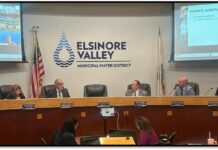The newly elected TVUSD Board of directors voted to ban Critical Race Theory (CRT) in Temecula schools during a raucous meeting on Dec. 13. It was the first meeting for Dr. Joseph Komrosky (President), Danny Gonzalez and Jen Wiersma, who make up the new majority on the TVUSD board of directors. Wiersma said they were making good on campaign promises.
The five-hour meeting was loud with students, parents and community members giving public comment for four of the five hours regarding the ban. However, a former TVUSD board member Barbra Bosch had previously stated that CRT was not actually being taught in Temecula. Wiersma said many parents have disagreed.
The next day, hundreds of students walked out of their classrooms in protest of the ban, carrying signs with messages against censorship.
CRT has been hotly debated across the country. Other districts have banned it, including Placentia-Yorba Linda Unified, according to EdSource.
TVUSD board member Steven Schwartz said Friday, Dec. 16, that he will ask board members at the next meeting to rescind the resolution and one that condemned racism until they can be vetted by an attorney.
President Komrosky said, “In response to the last school board meeting, there was a clear dilemma: on the one hand, it was great to see the civic engagement of the students who came to the event to share their thoughts on the resolution condemning racism and prohibiting the teaching of Critical Race Theory. On the other hand, it was sad to see most of them shout so loudly that it interfered with the school board’s ability to function in an orderly manner.
“Personally, instead of trying to win any particular argument with the public, I seek to understand why there is division over something as clearly defined as the concepts of racism and Critical Race Theory. Racism is wrong anywhere and everywhere. In other words, it is wrong to judge someone based on the color of their skin. Therefore, I was surprised at the response of the majority of students there.”
He continued, “For example, if any student, teacher, administrative employee, classified staff, etc. shamed somebody because of the color of their skin, then it is morally wrong because it devalues the inherent worth of the person. The person should be judged morally praiseworthy or morally blameworthy because of their character. Thus, there was a disconnect between some in the audience and these two resolutions due to a definitional problem and lack of understanding of what is at stake in our educational community.
“To exhaust this aforementioned dilemma, I will hold true to my promise to the audience that night and plan a robust community forum for the community with expert panelists speaking on the problematic concepts of CRT and racism. We also hope to put together committees to engage and discuss concerns surrounding these issues.
“Together, we will gain a better understanding of the resolutions passed and how we can protect our students, historical integrity, and curriculum requirements within our AP and IB classrooms. Achieving a clear understanding of what social-political impact CRT has within our educational setting and society at large, will greatly benefit TVUSD and future generations of Americans. Moreover, the students and teachers that shared their concerns regarding this issue, I look forward to your attendance. At this meeting, I will share the motivation behind why I decided to put these resolutions forward.”
Proponents of CRT examine and teach the role of institutions in racism throughout history and find institutional racism as pervasive throughout most of America, even in science, math, history, systems of Government, etc. One book that made the theory popular was “White Fragility,” by Robin J. DiAngelo, which describes a phenomenon by which all white people are complicit in systemic racism. She makes a case for why “it is incumbent upon white people to accept their individual and collective responsibility for white supremacy – and to do the difficult work of challenging it.”
CRT has been in existence for decades, but was also made popular by author Ibram X.Kendi, who directs the Center for Antiracist Research at Boston University. He had proposed the creation of a federal Department of Antiracism. It would be completely independent and unaccountable to elected branches of government, and would have the power to nullify, veto, or abolish any law at any level of government and curtail the speech of political leaders and others who are deemed insufficiently ‘antiracist.’ This was widely condemned as unconstitutional.
UCLA law professor and critical race theorist Cheryl Harris has proposed suspending private property rights, seizing land and wealth and redistributing them along racial lines with an emphasis on “equity” rather than equality, earning it the label of reformulated Marxism.
Wiersma said after the meeting that while she liked seeing the students using their free speech rights and participating in the process, she wished they could have stayed to hear the board members’ side. She said, “I am honored to be representing Trustee Area 3 on the TVUSD school board and look forward to serving as an advocate for parental rights, improving safety and security and defending choice and academic excellence. With the recent board decision to pass resolutions on racism and critical race theory, it’s important for our community to know we defend teaching all aspects of history and celebrating diversity. In doing so, the academic lens should not be one that asks us to critically find racism in every aspect of society, nor should it categorically lump students into an “oppressor” or “oppressed group” based on skin color. Rather, we believe an individual should be judged on the content of their character and choices, while simultaneously celebrating our student’s ethnicity and unique qualities as they pursue an excellent, well-rounded education.”








